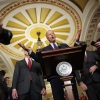Volkswagen plans to shut at least three German plants, axe tens of thousands of jobs and slash pay by 10 per cent, the company’s top employee representative said on Monday.
The restructuring would mark the first closure of domestic plants in the company’s 87-year history and set up a battle with powerful unions and politicians in Germany, where VW has 300,000 employees.
VW’s management has warned that radical measures are needed as Europe’s largest carmaker faces intense competition in China, slowing sales across other major markets and the need to navigate the costly transition to electric vehicles. It recently issued its second profit warning in three months.
Daniela Cavallo, the head of VW’s works council, on Monday told staff at the company’s main Wolfsburg plant that executives had two days to reverse its plans, as she hinted at future strikes.
She said chief executive Oliver Blume was “playing with the massive risk that . . . we will break off the talks and do what a workforce has to do when it fears for its existence”.
The works council represents VW employees and holds half the seats on the supervisory board.
The plants to be shut will come from 10 that mainly supply the carmaker’s core brand VW brand, according to a spokesperson for the works council.
VW first signalled in September that it was considering shutting German plants but analysts have remained sceptical given the strong opposition from politicians and the works council.
In a statement on Monday, Thomas Schäfer, the head of the company’s VW brand, said some of its German plants were twice as costly to run than those of rival carmakers.
“We are currently earning too little money from our cars,” he said. “At the same time, our costs for energy, materials and personnel have continued to rise. This calculation cannot work in the long term.”
VW declined to comment on the possible plant closures on Monday, referring to a previous statement that they cannot be ruled out.
Thorsten Gröger, chief negotiator at IG Metall, Europe’s largest union, warned that the cost-cutting would provoke “resistance of a kind it could never imagine”.
Politicians pointed to VW’s management for decisions that had contributed to the company’s current crisis. A spokesperson for the German government said Chancellor Olaf Scholz had been clear that “possible wrong management decisions in the past must not be to the detriment of employees”.
The parliamentary group for Scholz’s Social Democratic party echoed that view, with Verena Hubertz, SPD’s spokesperson on economic policy, saying: “The workers shouldn’t have to take the rap if management makes the wrong decisions.”
She said Scholz would on Tuesday hold “confidential talks with business and the unions” over safeguarding jobs and “ensuring that future investments are made in Germany”.
The German state of Lower Saxony, a significant shareholder with control of 20 per cent of the voting rights, has previously said its priority is maintaining jobs and has often sided with the works council.
Matthias Schmidt, an independent car analyst, predicted that following negotiations with the works council and the unions in coming weeks VW would probably end up closing two plants. “They are using some type of political manoeuvring to get a deal they want,” he added.
Like German rivals Mercedes-Benz and BMW, VW faces falling profits in China as consumers cut spending and local brands such as BYD take market share.
The German group, which reports its quarterly results on Wednesday, now expects an operating profit margin of about 5.6 per cent in 2024, down from its earlier forecast of 6.5 per cent to 7 per cent.
In a sign of the deepening pressures in the Chinese market, Porsche, which is majority owned by VW, on Friday reported a 41 per cent plunge in quarterly profits.
Additional reporting by Guy Chazan and Laura Pitel in Berlin







































